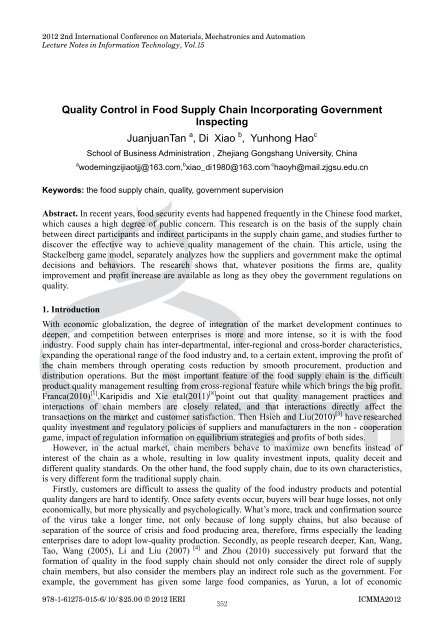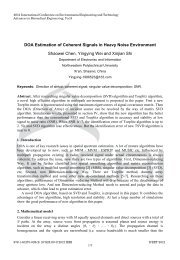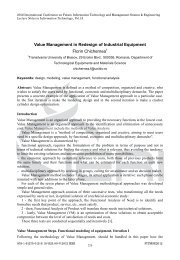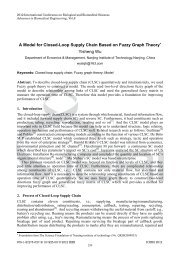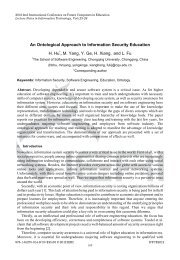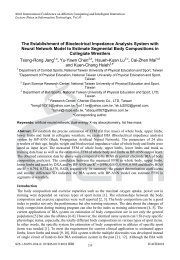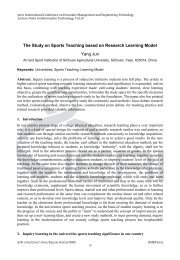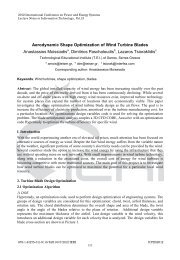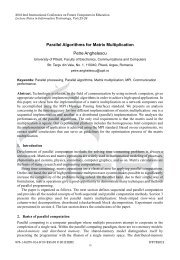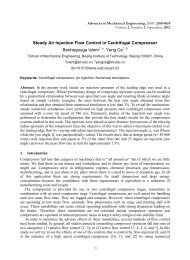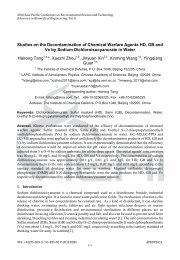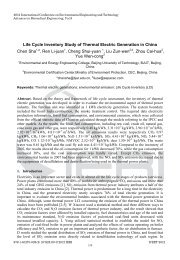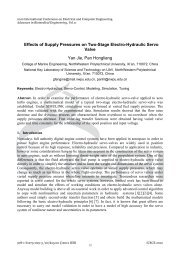Quality Control in Food Supply Chain Incorporating Government ...
Quality Control in Food Supply Chain Incorporating Government ...
Quality Control in Food Supply Chain Incorporating Government ...
You also want an ePaper? Increase the reach of your titles
YUMPU automatically turns print PDFs into web optimized ePapers that Google loves.
2012 2nd International Conference on Materials, Mechatronics and Automation<br />
Lecture Notes <strong>in</strong> Information Technology, Vol.15<br />
<strong>Quality</strong> <strong>Control</strong> <strong>in</strong> <strong>Food</strong> <strong>Supply</strong> Cha<strong>in</strong> Incorporat<strong>in</strong>g <strong>Government</strong><br />
Inspect<strong>in</strong>g<br />
JuanjuanTan a , Di Xiao b , Yunhong Hao c<br />
School of Bus<strong>in</strong>ess Adm<strong>in</strong>istration , Zhejiang Gongshang University, Ch<strong>in</strong>a<br />
a wodem<strong>in</strong>gzijiaotjj@163.com, b xiao_di1980@163.com c haoyh@mail.zjgsu.edu.cn<br />
Keywords: the food supply cha<strong>in</strong>, quality, government supervision<br />
Abstract. In recent years, food security events had happened frequently <strong>in</strong> the Ch<strong>in</strong>ese food market,<br />
which causes a high degree of public concern. This research is on the basis of the supply cha<strong>in</strong><br />
between direct participants and <strong>in</strong>direct participants <strong>in</strong> the supply cha<strong>in</strong> game, and studies further to<br />
discover the effective way to achieve quality management of the cha<strong>in</strong>. This article, us<strong>in</strong>g the<br />
Stackelberg game model, separately analyzes how the suppliers and government make the optimal<br />
decisions and behaviors. The research shows that, whatever positions the firms are, quality<br />
improvement and profit <strong>in</strong>crease are available as long as they obey the government regulations on<br />
quality.<br />
1. Introduction<br />
With economic globalization, the degree of <strong>in</strong>tegration of the market development cont<strong>in</strong>ues to<br />
deepen, and competition between enterprises is more and more <strong>in</strong>tense, so it is with the food<br />
<strong>in</strong>dustry. <strong>Food</strong> supply cha<strong>in</strong> has <strong>in</strong>ter-departmental, <strong>in</strong>ter-regional and cross-border characteristics,<br />
expand<strong>in</strong>g the operational range of the food <strong>in</strong>dustry and, to a certa<strong>in</strong> extent, improv<strong>in</strong>g the profit of<br />
the cha<strong>in</strong> members through operat<strong>in</strong>g costs reduction by smooth procurement, production and<br />
distribution operations. But the most important feature of the food supply cha<strong>in</strong> is the difficult<br />
product quality management result<strong>in</strong>g from cross-regional feature while which br<strong>in</strong>gs the big profit.<br />
Franca(2010) [1] ,Karipidis and Xie etal(2011) [8] po<strong>in</strong>t out that quality management practices and<br />
<strong>in</strong>teractions of cha<strong>in</strong> members are closely related, and that <strong>in</strong>teractions directly affect the<br />
transactions on the market and customer satisfaction. Then Hsieh and Liu(2010) [3] have researched<br />
quality <strong>in</strong>vestment and regulatory policies of suppliers and manufacturers <strong>in</strong> the non - cooperation<br />
game, impact of regulation <strong>in</strong>formation on equilibrium strategies and profits of both sides.<br />
However, <strong>in</strong> the actual market, cha<strong>in</strong> members behave to maximize own benefits <strong>in</strong>stead of<br />
<strong>in</strong>terest of the cha<strong>in</strong> as a whole, result<strong>in</strong>g <strong>in</strong> low quality <strong>in</strong>vestment <strong>in</strong>puts, quality deceit and<br />
different quality standards. On the other hand, the food supply cha<strong>in</strong>, due to its own characteristics,<br />
is very different form the traditional supply cha<strong>in</strong>.<br />
Firstly, customers are difficult to assess the quality of the food <strong>in</strong>dustry products and potential<br />
quality dangers are hard to identify. Once safety events occur, buyers will bear huge losses, not only<br />
economically, but more physically and psychologically. What’s more, track and confirmation source<br />
of the virus take a longer time, not only because of long supply cha<strong>in</strong>s, but also because of<br />
separation of the source of crisis and food produc<strong>in</strong>g area, therefore, firms especially the lead<strong>in</strong>g<br />
enterprises dare to adopt low-quality production. Secondly, as people research deeper, Kan, Wang,<br />
Tao, Wang (2005), Li and Liu (2007) [4] and Zhou (2010) successively put forward that the<br />
formation of quality <strong>in</strong> the food supply cha<strong>in</strong> should not only consider the direct role of supply<br />
cha<strong>in</strong> members, but also consider the members play an <strong>in</strong>direct role such as the government. For<br />
example, the government has given some large food companies, as Yurun, a lot of economic<br />
978-1-61275-015-6/10/$25.00 ©2012 IERI ICMMA2012<br />
352
<strong>in</strong>centives <strong>in</strong> order to promote their productions. Then enterprises like this don’t have to fear the<br />
consequences of their poor quality.<br />
Besides, more other literatures have talked about the effect of government supervision of<br />
products. S<strong>in</strong>ce the government's safety supervision system reform of developed countries <strong>in</strong> 1990,<br />
Ch<strong>in</strong>a has undergone a series of food safety issues <strong>in</strong> recent years, caus<strong>in</strong>g customers <strong>in</strong> the market<br />
pay<strong>in</strong>g more and more attention to food quality. Zhan and Kong (2004), Yu and Zhou (2005) and<br />
Wang (2011) [9] , from the perspective of game theory, po<strong>in</strong>t out that the quality of the products <strong>in</strong><br />
the food <strong>in</strong>dustry is the result of coord<strong>in</strong>ation jo<strong>in</strong>tly by the enterprise and government.<br />
2. Dynamic game model of <strong>Government</strong> and Enterprise<br />
2.1 Basic assumptions and models<br />
In order to facilitate the analysis, this paper makes the follow<strong>in</strong>g basic assumptions under the<br />
premise of no affect<strong>in</strong>g the results: 1) In a oligopoly market of the food <strong>in</strong>dustry,customers choose<br />
products consider<strong>in</strong>g the price of the products p e<br />
and the quality of all products i . 2) The<br />
participants have the same <strong>in</strong>formation about the behavioral characteristics,strategies and revenue<br />
functions of other actors. The game has only two participants: government and food production<br />
enterprises. They make decisions respectively on the degree of probability and quality efforts. 3)<br />
<strong>Food</strong> sales is D . The cost of government supervision us<strong>in</strong>g adm<strong>in</strong>istrative means is θ Dm<br />
. The<br />
probability of government detection isθ . <strong>Government</strong> <strong>in</strong>spection cost for each product is m . If the<br />
government f<strong>in</strong>ds out the quality of the product is lower than the requirements, penalty on producer<br />
is d . 4) Orders of government’s and enterprises’ behaviors are not consistent. Both sides decide<br />
their actions based on self-<strong>in</strong>terest maximization .<br />
The Demand Curve<br />
Market demand producers face is uncerta<strong>in</strong>, so the article sets the demand function on the basis<br />
of the one Lu (2008) putted forward:<br />
The demand function is De () = l+ αe<br />
(1)<br />
i<br />
Inside: α represents the entire needs of customers <strong>in</strong> the whole market, which reflects the<br />
development level of the product <strong>in</strong> the market as a whole (Banker R D, 1998).<br />
2.2 <strong>Government</strong> decides first. The enterprise undertakes strategic analysis.<br />
This article establishes a two-stage game model accord<strong>in</strong>g to the relationship between government<br />
and the lead<strong>in</strong>g enterprises <strong>in</strong> the supply cha<strong>in</strong>. The first stage is government decision mak<strong>in</strong>g on<br />
detection, and the second stage is enterprise’s choice of quality efforts strategy under the estimation<br />
of the probability of governmental detection.<br />
kG<br />
First, government's utility function is U ( θ ) = ln<br />
G 1- θ<br />
, ( ) '<br />
0, ( )<br />
'<br />
U θ > U θ < 0<br />
G<br />
G , and kG<br />
is the<br />
government utility parameters , θ ∈(0,1) .<br />
So the government's benefits is<br />
⎧ k<br />
G<br />
⎪ln -θDm + γ ( ei-e L)<br />
+ d , e<br />
ieH<br />
⎩ 1-θ<br />
After the government determ<strong>in</strong>es his own strategy, produc<strong>in</strong>g company will determ<strong>in</strong>e the<br />
quality strategy based on the strategy of the government. Company’s demand function is (1). The<br />
government will give each <strong>in</strong>dustry the correspond<strong>in</strong>g quality requirements <strong>in</strong> the beg<strong>in</strong>n<strong>in</strong>g of the<br />
<strong>in</strong>dustry production. Assum<strong>in</strong>g the quality requirements are set from e L<br />
to e H ,<br />
and producer’s cost<br />
353
of quality effort under the given requirement is<br />
K M , and<br />
KM<br />
is an <strong>in</strong>creas<strong>in</strong>g convex function,<br />
2<br />
kei<br />
e<br />
which means i , KM '( ei) > 0, KM ''( ei) > 0 . The function of quality effort is<br />
K<br />
M<br />
=<br />
2 (3),<br />
and the<br />
quality effort cost parameter k>0. Similar cost function of quality effort is also used by Gurnani and<br />
Erkoc(2008),Kaya and Ozer (2009).<br />
e<br />
H<br />
The company’s profit is<br />
2<br />
⎧ kei<br />
⎪ DM − − [ θϕd + θ (1 − ϕ)0 ],<br />
ei<br />
< e<br />
⎪<br />
2<br />
2<br />
⎪ kei<br />
Π<br />
M<br />
= ⎨ DM − , eL ≤ ei<br />
≤ eH<br />
⎪ 2<br />
2<br />
⎪ kei<br />
⎪ DM − +R<br />
G,<br />
ei<br />
> eH<br />
2<br />
⎩ (4)<br />
α<br />
As can be seen from above <strong>in</strong> either case, company face reflected function is ( p-c)<br />
ei<br />
=<br />
k<br />
Here, on<br />
e ∗ i<br />
case discussion,we know that<br />
⎧ M + kR M + M −k Me − R −ke<br />
⎪ e < e < < e e < e <<br />
⎪ k k k k k<br />
∗ ⎪αM αM αM+ 2kRG<br />
αM<br />
αM+<br />
2kθϕd<br />
αM+ 2 k( θϕd+<br />
RG<br />
)<br />
ei = ⎨ , 当 < eH且 eH > ; 若 < eL, eL > , eH<br />
><br />
⎪ k k k k k k<br />
⎪ αM+ α M − (2kR + 2 kαMe − k e ) αM+<br />
2kθϕd<br />
⎪ < < <<br />
k k k<br />
2 2 2<br />
αM<br />
α 2<br />
G αM<br />
αM+<br />
2kθϕd<br />
α α (2α<br />
L<br />
2<br />
G L<br />
)<br />
H, 当<br />
H<br />
; 若<br />
L, H<br />
,<br />
H<br />
2 2 2 2<br />
αM<br />
G H H<br />
eL 当 eL , eL<br />
⎪⎩ , ,<br />
α M<br />
eL<br />
k<br />
<<br />
( 一 )If the<br />
(A)The government quality level l<strong>in</strong>e is <strong>in</strong> the range<br />
2 2 2<br />
αM + 2kθϕ d αM + α M −k(2αMeL −2 RG −keL<br />
)<br />
< , eH<br />
<<br />
k<br />
k<br />
Enterprise will choose eH<br />
as the quality level<br />
kG<br />
∏<br />
G<br />
= ln − θ( l+ αeH) m+ r( eH −eL)<br />
At this time 1−<br />
θ<br />
The government <strong>in</strong> order to achieve maximum profits, θ on both sides to be derivative<br />
1<br />
θ = 1 − ( l + αe ) m<br />
H<br />
2<br />
keH<br />
∏<br />
M<br />
= ( l+ αeH)<br />
M − + RG<br />
∏<br />
G<br />
= ln kG( l+ αeH) m− ( l+ αeH) m+ 1 + r( eH −eL)<br />
2<br />
,<br />
(7)<br />
αM + 2kθϕ d αM + 2 k( θϕd + RG<br />
)<br />
eL<br />
> , eH<br />
><br />
(B) From the condition, we can get<br />
k<br />
k<br />
M<br />
e<br />
∗ = α<br />
Enterprise will choose i<br />
k<br />
kG<br />
αM αM<br />
∏<br />
G<br />
= ln − θ( l+ α ) m+ r( − eL)<br />
+ d<br />
1− θ k k<br />
(8)<br />
The government <strong>in</strong> order to achieve maximum profits, θ on both sides to be derivative<br />
1 k<br />
θ = − ( 2<br />
kl + α M ) m<br />
Put (7) and (9) <strong>in</strong> (8)<br />
2 2<br />
α M ( kl+<br />
α M)<br />
m αM<br />
G G L<br />
∏ = ln k ( l+ ) m− + r( − e ) + d<br />
k k k ,<br />
2 2 2<br />
α M ( kl+ α M) m−1<br />
∏<br />
M<br />
= lM + −<br />
ϕd<br />
2<br />
2 k ( kl+<br />
α M)<br />
m<br />
L<br />
(5)<br />
(6)<br />
(9)<br />
(10)<br />
354
(C)if<br />
e<br />
< L, αM + α M − (2kR + 2 kαMe −k e )<br />
Enterprise will choose ei<br />
2 2 2 2<br />
G H H<br />
∗ =<br />
k<br />
e<br />
L<br />
,<br />
αM + 2kθϕd<br />
eL<br />
<<br />
k<br />
, We can get 1<br />
θ = 1 − ( l + αe ) m<br />
2<br />
∏<br />
G<br />
= ln kG( l+ αeL) m− ( l+ αeL) m+ 1<br />
keL<br />
, ∏<br />
M<br />
= ( l+ αeL)<br />
M −<br />
2<br />
(11)<br />
α M<br />
e < < e<br />
( 二 )When L k<br />
H<br />
,<br />
(D)At this time α M + 2kR<br />
e<br />
G<br />
H<br />
><br />
Enterprise will choose<br />
M<br />
e<br />
∗ i<br />
= α<br />
2<br />
k ,<br />
k ,<br />
1 k<br />
θ = − ( lk + α M ) m<br />
2 2<br />
2 2 2<br />
α M ( lk+ α M)<br />
m−k αM<br />
α M α M<br />
∏<br />
G<br />
= ln kG( l+ ) m− + r( −eL)<br />
∏<br />
M<br />
= ( l+ ) M −<br />
k k k ,<br />
k 2 (12)<br />
(E)<br />
If α M + 2kR<br />
e<br />
G<br />
H<br />
<<br />
k<br />
Enterprise will choose e<br />
∗ i<br />
= eH<br />
.<br />
The condition is the same to the (A)<br />
2<br />
∏<br />
G<br />
= ln kG( l+ αeH) m− ( l+ αeH) m+ 1 + r( eH −eL)<br />
keH<br />
, ∏<br />
M<br />
= ( l+ αeH)<br />
M − + R<br />
(13)<br />
G<br />
( 三 )If<br />
αM<br />
> e<br />
H<br />
k<br />
(F)Enterprise will choose<br />
2.3 Simulation analysis<br />
M<br />
e<br />
∗ i<br />
= α<br />
k<br />
2<br />
,<br />
1 k<br />
θ = − ( lk + α M ) m<br />
2 2<br />
α M ( lk+ α M)<br />
m−k αM<br />
G<br />
ln kG( l ) m r( eL)<br />
RG<br />
∏ = + − + − −<br />
k k k<br />
,<br />
L<br />
2 2 2<br />
α M α M<br />
∏<br />
M<br />
= ( l+ ) M − + R<br />
k 2<br />
In the context of enterprise determ<strong>in</strong><strong>in</strong>g his own level of quality efforts consider<strong>in</strong>g the<br />
e<br />
government’s strategy, we set<br />
L<br />
= 1.5<br />
,<br />
e<br />
H<br />
= 2 ,the product’s profit per unit is M=8<br />
From the diagram we can see that enterprise profit <strong>in</strong>creases as the promotion of quality level.<br />
3. Summary<br />
From the above chart, we can see enterprises’ profits will <strong>in</strong>crease if they strictly implement the<br />
policy after the government work<strong>in</strong>g out specific provisions. And as the product quality is<br />
constantly improved, firm’s profit will undergo a large degree of promotion.<br />
Table 1 Based on <strong>Government</strong> - led supply cha<strong>in</strong> quality management<br />
e ∗ θ ∏<br />
i<br />
M<br />
∏<br />
G<br />
0.9000<br />
1.2000<br />
1.5000<br />
1.8000<br />
2.1000<br />
2.4000<br />
2.7000<br />
3.0000<br />
3.3000<br />
3.6000<br />
0.2683<br />
0.5652<br />
0.7143<br />
0.7987<br />
0.8507<br />
0.8851<br />
0.9088<br />
0.9259<br />
0.9387<br />
0.9484<br />
-11.9672<br />
-13.6750<br />
-16.2449<br />
-19.7241<br />
-24.1235<br />
-29.4445<br />
-35.6852<br />
-42.8434<br />
-50.9169<br />
-59.9036<br />
22.7750<br />
29.6000<br />
38.3750<br />
49.1000<br />
61.7750<br />
76.4000<br />
92.9750<br />
111.5000<br />
131.9750<br />
154.4000<br />
2<br />
G<br />
(14)<br />
355
4<br />
3.5<br />
企 企 利 利<br />
政 政 利 利<br />
3<br />
质 质 质 质<br />
2.5<br />
2<br />
1.5<br />
1<br />
0.5<br />
-100 -50 0 50 100 150 200<br />
利 利<br />
Figure 1 <strong>Government</strong> first, the enterprise underwent<br />
In this process, the government itself through reward <strong>in</strong>centives to raise the level of quality of<br />
enterprise, <strong>in</strong> the run cont<strong>in</strong>ued decl<strong>in</strong>e <strong>in</strong> themselves’ profits, but we know, the <strong>Government</strong>'s profit<br />
is the sum of the profits of the community as a whole, profit enterprises get far more than the<br />
<strong>Government</strong> <strong>in</strong> part of the losses by the correspond<strong>in</strong>g quality levels.<br />
Of course, this discussion is only considered a production enterprises <strong>in</strong> the supply cha<strong>in</strong>, and<br />
does not <strong>in</strong>volve other members of the supply cha<strong>in</strong>, and <strong>in</strong> the reality of supply cha<strong>in</strong> always exist<br />
<strong>in</strong> horizontal or vertical competition, those competition <strong>in</strong> the supply cha<strong>in</strong> have a great effect on<br />
enterprise profits.Therefore, the study about this two aspect will become supply cha<strong>in</strong> quality<br />
strategy directions for further research <strong>in</strong> this article.<br />
Acknowledgement<br />
The authors are very grateful to Xiao Di for his permission and help <strong>in</strong> the National Natural Science<br />
Foundation of Ch<strong>in</strong>a (No.70902072), Social Sciences Foundation of M<strong>in</strong>istry of Education of Ch<strong>in</strong>a<br />
(No. 09YJC630201,10YJC630004) and Ch<strong>in</strong>a Postdoctoral Science Foundation (No. 20110491823).<br />
Reference<br />
[1]Franca, R.B., et al., Multi-objective stochastic supply cha<strong>in</strong> model<strong>in</strong>g to evaluate tradeoffs<br />
between profit and quality. International Journal of Production Economics, 2010. 127(2): p.<br />
292-299.<br />
[2]Han, J., J.H. Trienekens and S. Omta, Relationship and quality management <strong>in</strong> the Ch<strong>in</strong>ese pork<br />
supply cha<strong>in</strong>. International Journal of Production Economics, 2009.<br />
[3]Hsieh, C.C. and Y.T. Liu, <strong>Quality</strong> <strong>in</strong>vestment and <strong>in</strong>spection policy <strong>in</strong> a supplier-manufacturer<br />
supply cha<strong>in</strong>. European Journal of Operational Research, 2010. 202(3): p. 717-729.<br />
[4]LI Yan-bo1; LIU Song-xian2 A Game Analysis between Director Departments of the<br />
<strong>Government</strong> and <strong>Food</strong> Corporations on <strong>Food</strong> Safety <strong>Supply</strong> Cha<strong>in</strong>.2007(01):p.35-38<br />
[5]LU Qi-hui,ZHU Dao-li. Research on equilibriums and coord<strong>in</strong>ation strategies of supply cha<strong>in</strong>s<br />
with quality and price competition. Journal of management science. 2009(6).<br />
[6]Mazé, A., et al. <strong>Quality</strong> Signals and Governance Structures with<strong>in</strong> European Agro-food Cha<strong>in</strong>s:<br />
A New Institutional Economics Approach. 2001.<br />
[7]Rong , A., R. Akkerman and M. Grunow, An optimization approach for manag<strong>in</strong>g fresh food<br />
quality throughout the supply cha<strong>in</strong>. International Journal of Production Economics, 2011.<br />
356
131(1): p. 421-429.<br />
[8]Vetter, H. and K. Karant<strong>in</strong><strong>in</strong>is, Moral hazard, vertical <strong>in</strong>tegration, and public monitor<strong>in</strong>g <strong>in</strong><br />
credence goods. European Review of Agricultural Economics, 2002. 29(2): p. 271.<br />
[9]Wang Yaozhong. A Study on Horizontal and Vertical Configuration of <strong>Food</strong> Safety<br />
Adm<strong>in</strong>istration. Ch<strong>in</strong>a Industrial Economy.2005(12):p.64-70.<br />
[10]Xie, G., et al., <strong>Quality</strong> <strong>in</strong>vestment and price decision <strong>in</strong> a risk-averse supply cha<strong>in</strong>. European<br />
Journal of Operational Research, 2011. 214(2): p. 403-410.<br />
357


